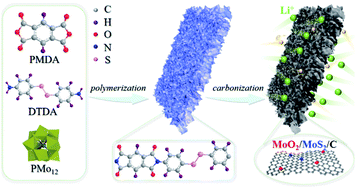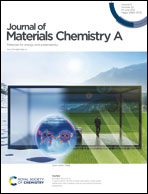Heteroarchitecturing a novel three-dimensional hierarchical MoO2/MoS2/carbon electrode material for high-energy and long-life lithium storage†
Abstract
The urgent desire for high-energy lithium-ion batteries (LIBs) has motivated scientists to develop large-capacity electrode materials with innovative compositions and/or architectures. Herein, we report a three-dimensional (3D) hierarchical MoO2/MoS2/C heterostructure composed of tiny crumpled nanosheets arrayed on a larger lamellar substrate through a facile hydrothermal polymerization–carbonization route. Benefiting from the intrinsically high capacity contribution from Mo-based components, expedited charge transfer from the intimately integrated carbon matrix, sufficient electrolyte penetration, rapid lithium transportation and volume change tolerance from the 3D hierarchical heteroconfiguration, our MoO2/MoS2/C demonstrates an appreciable reversible capacity (787.5 mA h g−1 at 0.1 A g−1), outstanding rate performance (80% capacity retention even as the current density increases tenfold), and superior long-term cyclability with a slow fading of 0.02% per cycle over 2000 cycles, holding great promise for the fabrication of desirable LIBs with high energy density and long lifetimes.

- This article is part of the themed collection: Journal of Materials Chemistry A HOT Papers


 Please wait while we load your content...
Please wait while we load your content...